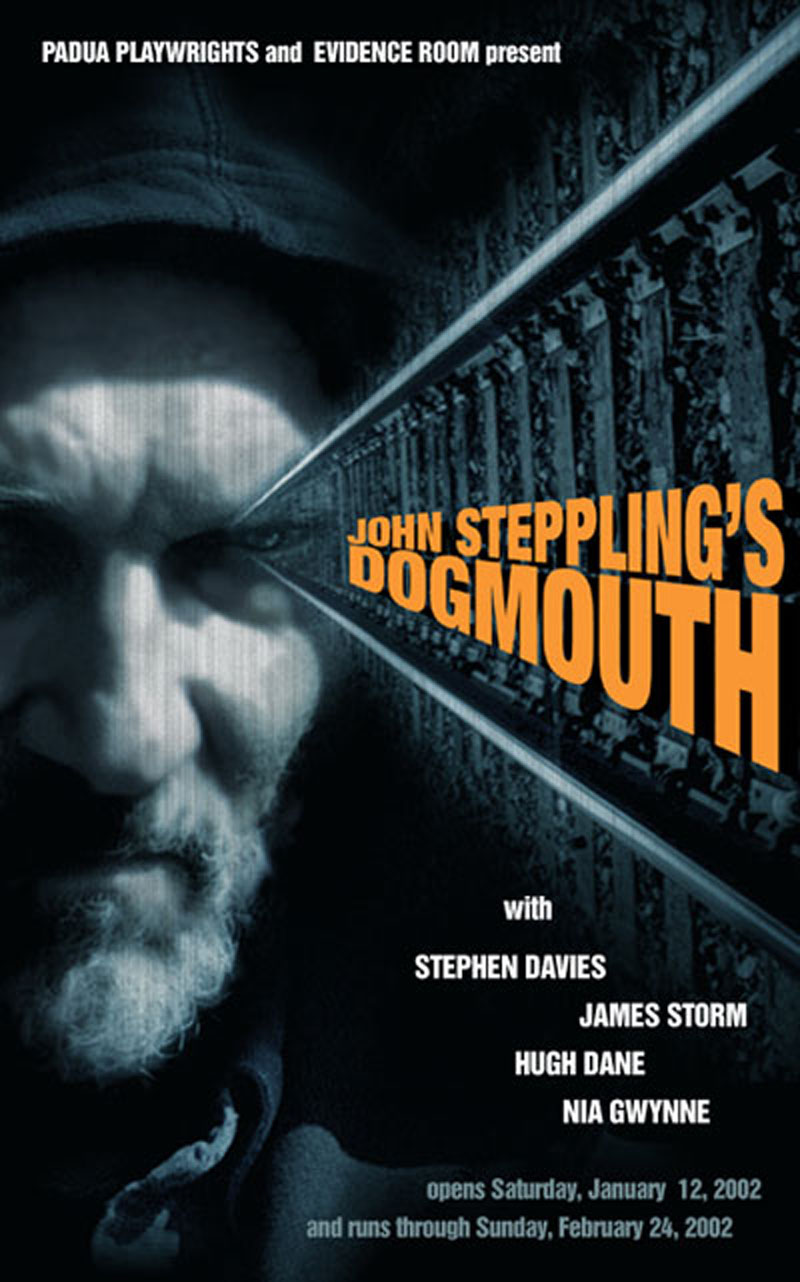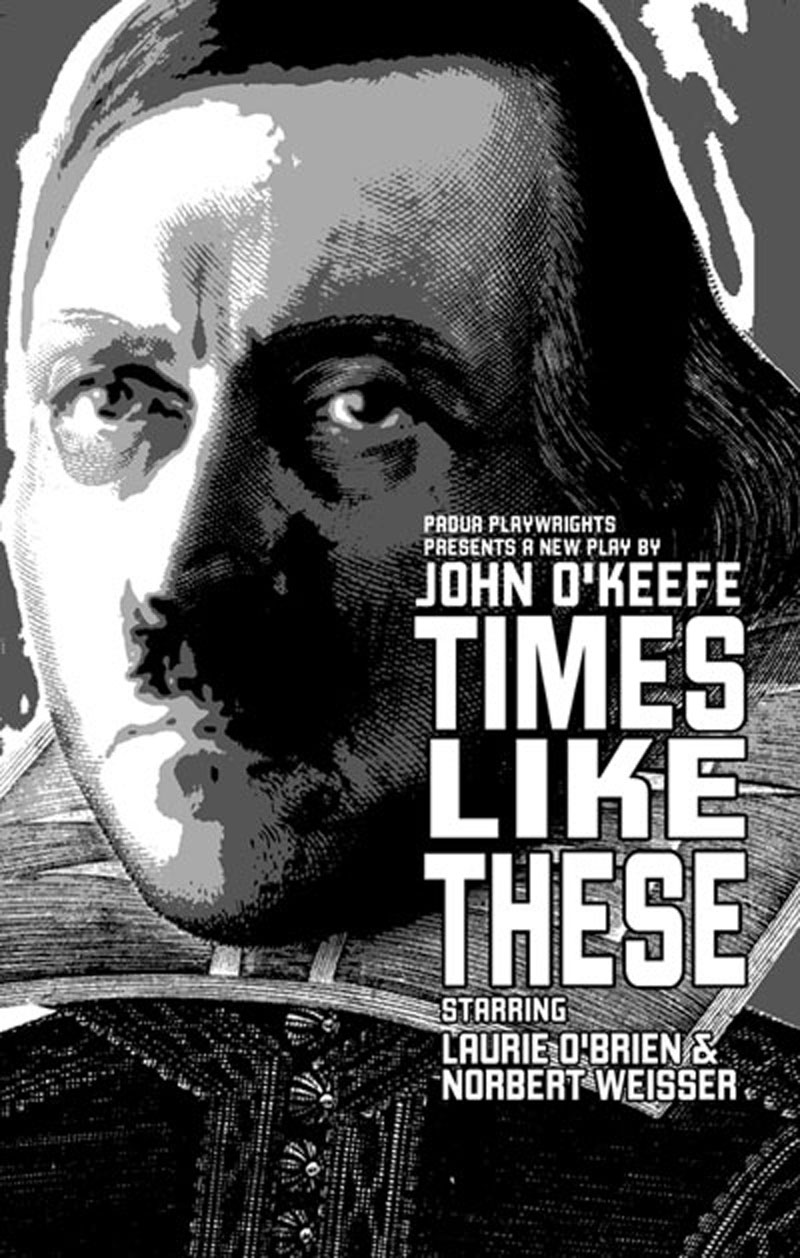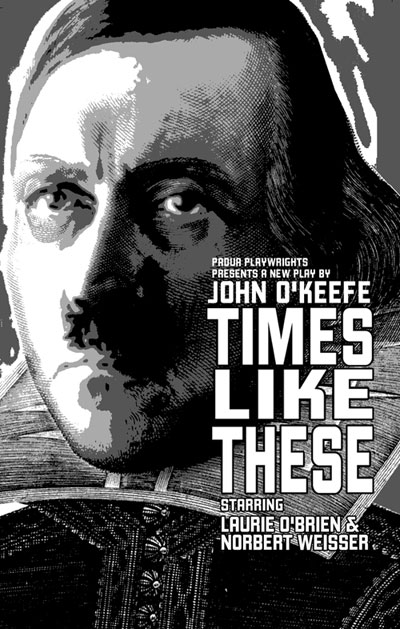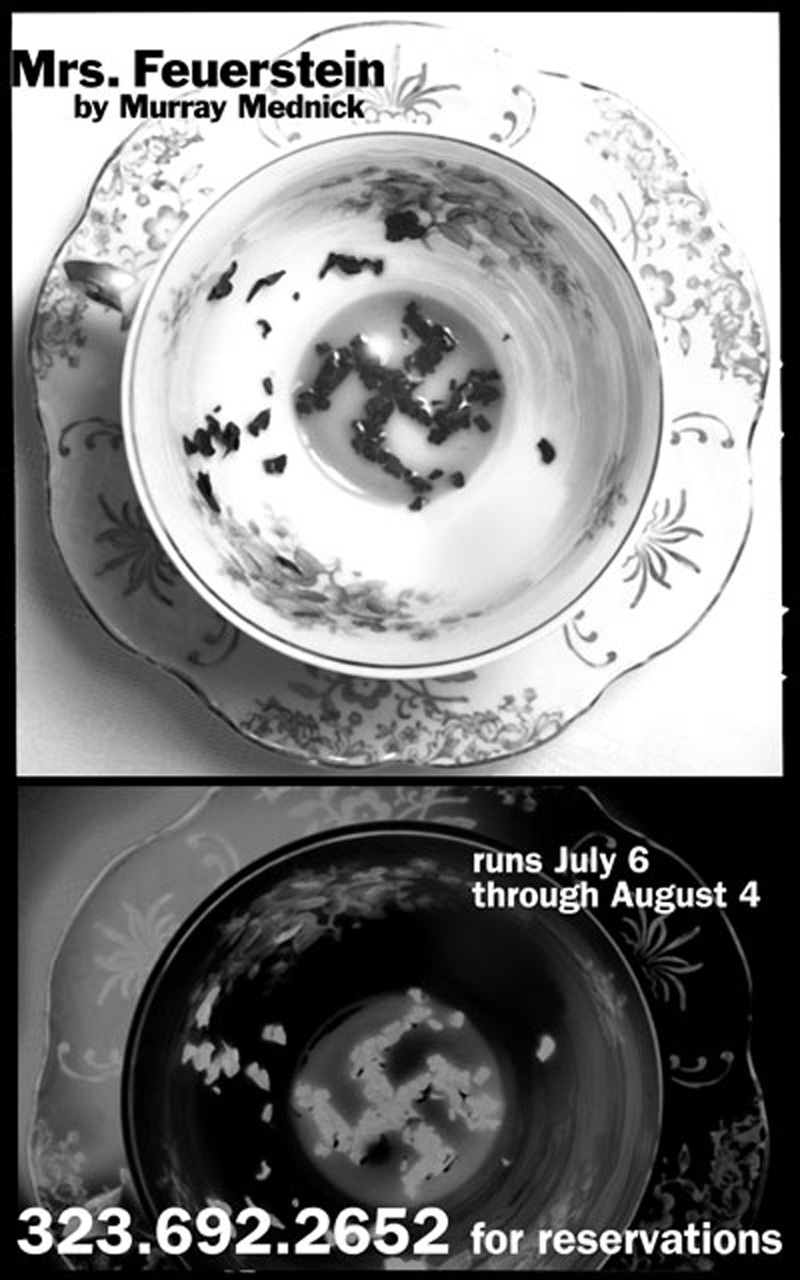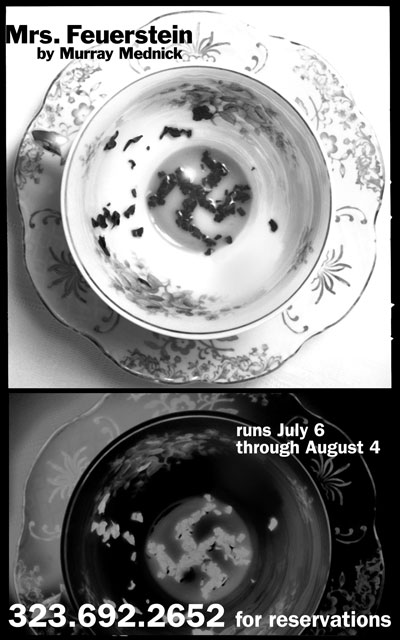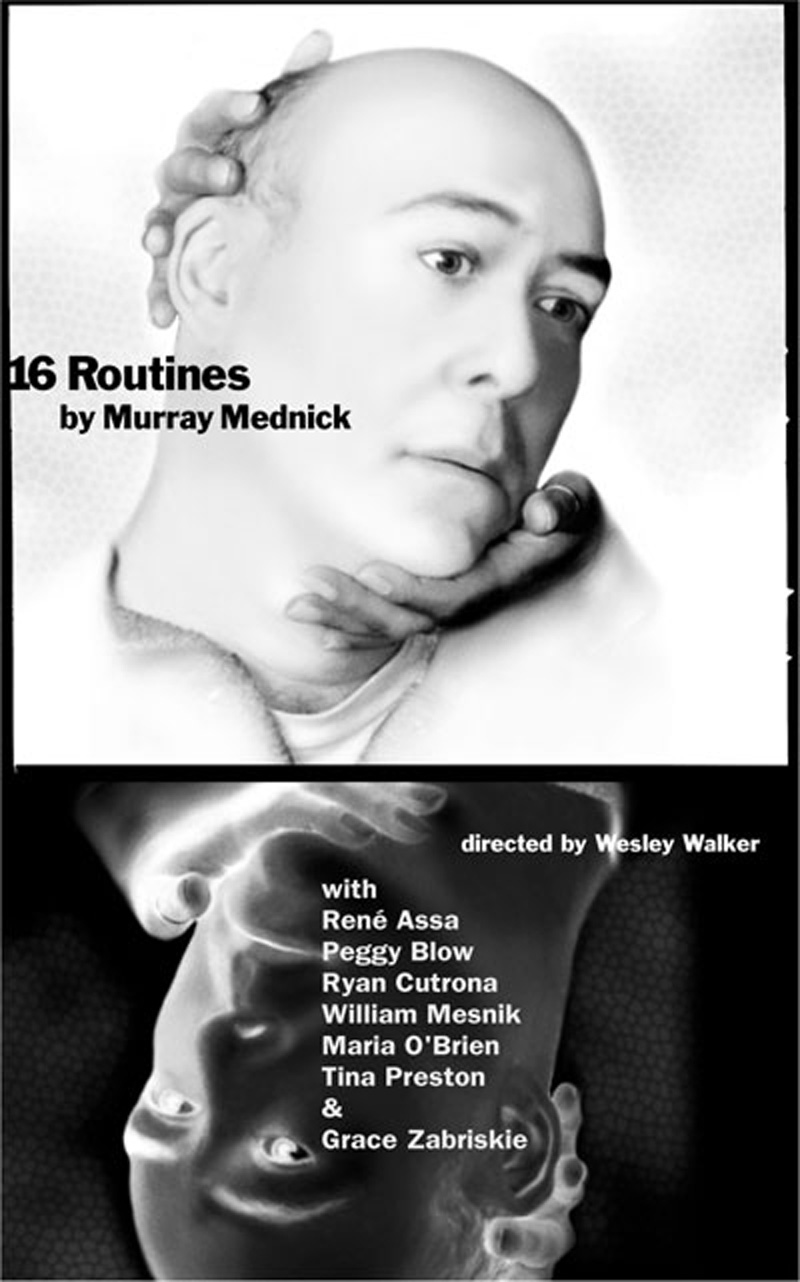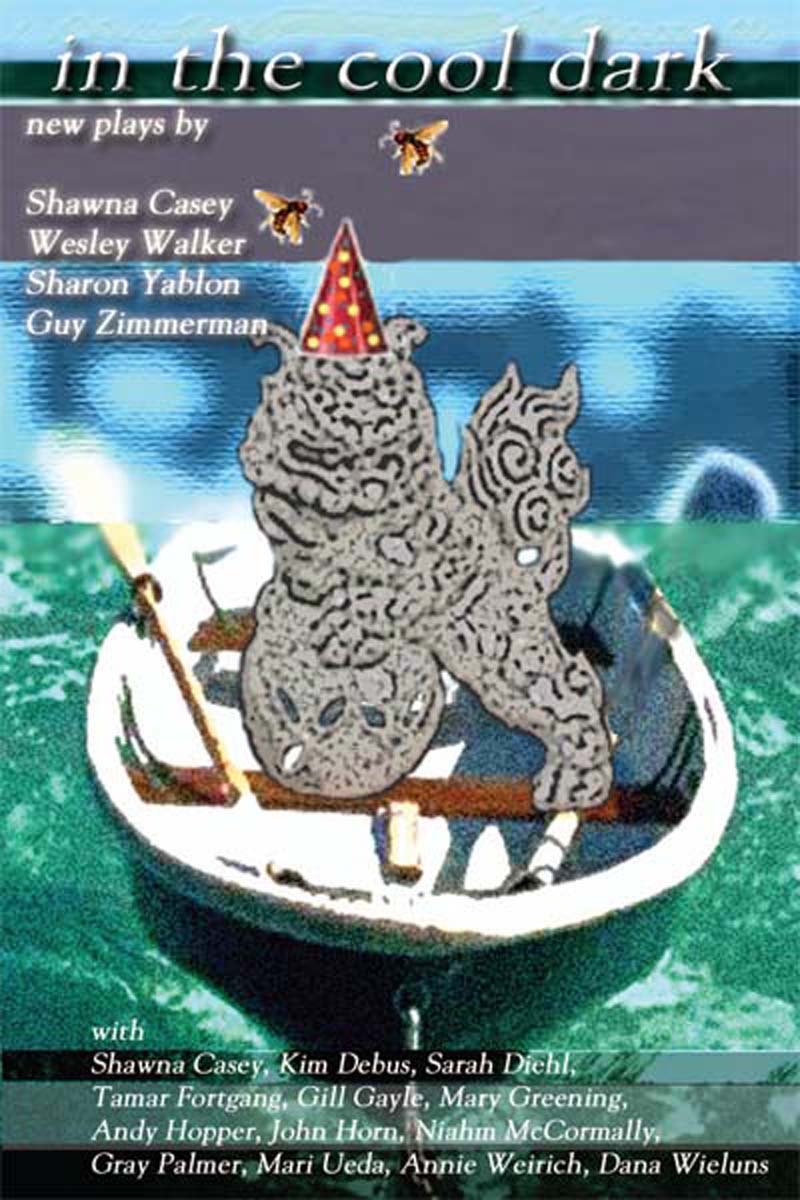Dog Mouth
Written and directed by John Steppling, The Evidence Room, January 12 through February 17, 2002.
In 1999, John e-mailed from Paris to tell me he’d started writing a new play. I received Dog Mouth a couple of weeks later, pretty much in its current form. From the first lines I sensed the influence of, dare I say it, Shakespeare. John’s characters were thinking out loud a little more than they used to and, having helped him stage versions of Macbeth and the Tempest a few years earlier, Shakespeare seemed a good explanation. At the same time, there were, of course, other, more familiar echoes — Samuel Beckett and Blind Willie McTell … Melville, Parmenides and Eddie Bunker …
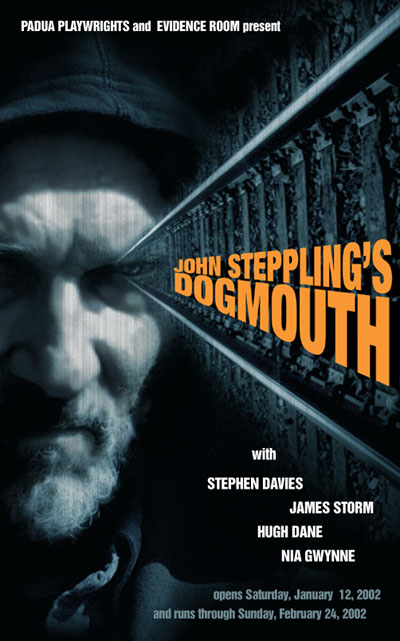
His interest piqued by lurid news accounts of a gang of rail-riding criminal hobos, John takes as his subject the mythic construct of the American West, which he both dismantles and extends. The reigning deity of this landscape is the locomotive. Seductive and powerful, this off-stage presence embodies the iron laws of fate, and also the horizontal nature of America’s mastery over the earth. To counter its inexorable forward-ing impulse, the playwright invokes the vastness of the Western sky, a symbol of freedom and absolute potential. Meanwhile, from off to the side, we hear the harsh music of fighting dogs — survival in this world remains a savage affair.
Confronted with the scope and mastery of John’s recent work, one is forced to ask how Dog Mouth could be his first main stage production in nearly ten years. What taboos does his writing break? Well, first of all, John’s characters inhabit a world in which bourgeois values simply do not exist. The idea that this is even possible is deeply threatening to the guardians of middle-class morality, more so than any explicit critique could ever be. Secondly, and this is where he most resembles Murray Mednick, John’s plays are drenched in an awareness of mortality – drenched, that is, in the unhappy knowledge that we are beings who will inevitably die. The anguish of this awareness is everywhere in Dog Mouth. In the lush rhythms of the dialogue, it pours off the stage. For a culture increasingly devoted to a denial of mortality, this feature of John’s work is utterly unwelcome. Intimidated by the realities of birth and death, we prefer to retreat into the superficialities of our consumer paradise, as if superficiality itself might somehow save us. Dog Mouth (and Weeks as well) is a tragic hero – an “aristocrat of being” – if only because he refuses to participate in this demeaning charade.
Like Murray Mednick, John’s response to the cultural shift that happened in the early 90s – a time when the basic premises of artistic activity were suddenly called into question – was to dig deep. The lyrical realism of the Steppling style has never been more full-blooded, more haunted and evocative, than in this beautiful play.
Guy Zimmerman – Artistic Director
With Steve Davies, Jim Storm, Nia Gwynne and Hugh Dane. Set by Jason Adam, lights by Rand Ryan.
Reviews
Fans of John Steppling won’t be disappointed with “Dog Mouth,” the latest work from a playwright whose bite is as impressively bleak as his bark. Others might not be so generous. With Steppling, you always get what you pay for, and with “Dog Mouth,” which he also directs, the price is particularly steep.
Steppling returns to the L.A. stage community from which he sprang, after an absence of nearly 10 years, with a fresh supply of his favorite ammunition — alienation.
For some playwrights, alienation is merely a pose or a way to gripe without paying your dues as an artist. For Steppling and his marginalized loners, drifters and dreamers, the alienation runs so deep that it becomes the unspoken premise behind every failed transaction and disaffected decision they make.
In “Dog Mouth,” playing through Feb. 17 at Evidence Room in Los Angeles, Steppling has found a setting and story equal to his outlook. Jason Adams’ set is a sweeping desert vista bisected diagonally by a spike of railroad track stretching from the audience into the barren distance. Karl Lundeberg’s haunting sound design is filled with echoes of rattling freight cars, steaming locomotives, plaintive train whistles and the rhythmic clickity-clack of endless journeys to the interior of nowhere. We are in that special space where the alienated spirit flourishes like a cactus baking in the noonday sun.
The play centers on Dog Mouth (Stephen Davies), a rail-riding hobo with a pitiless disposition. Davies imbues the character with the look of a man who has swallowed dynamite and is about to spit out an explosion. The intensity of his performance helps a play that has very little plot. Dog Mouth appears to be the leader of a loose-knit group of criminal hoboes, though what their crimes are remains a mystery — one among many. We get only the sketchiest details about Dog Mouth’s past and what has brought him, at age 55, to his present circumstances, but the fact that he and another hobo, Becker (James Storm), are Vietnam vets offers a clue.
There’s also an outcast young woman, Nyah (Nia Gwynne), who is carrying Dog Mouth’s baby and appears to love him, though he shows little interest in her or the baby.
The play’s fourth character is Weeks, a black dog breeder, well-played by Hugh Dane. The one — and only — matter about which Dog Mouth appears to care is breeding fighting dogs, an activity he once engaged in with some success and intends to do again.
But does he really intend this, and does it matter? Dog Mouth is living in an existential crater carved from his alienation. He has his freedom, an iron will and an inexhaustible supply of contempt to keep himself company. The fact that he also has unbearable hemorrhoids, cancer, an awareness of approaching death and no hope (or even desire) to change any of this seems almost beside the point. This isn’t a person; it’s King Lear, Vladimir, Estragon, Lucky and Job rolled into one.
While there’s a certain fascination in watching a character drawn this extreme and uncompromising, after a while the bleakness begins to curdle. The play seems neither as brave nor as deep as it would like to be, appearing to exist in some strange no man’s land born of Steppling’s ambitious imagination.
In this bitter landscape, alienation rules, but not always believably and with a heavy hand.
Jay Reiner, Hollywood Reporter
A decade ago, if you had asked L.A. theater insiders who was the quintessential L.A. playwright, John Steppling probably would have headed the list.
Steppling’s bleak, elliptical dramas about the underbelly of the Southern California dream had been produced often in small L.A. theaters in the 1980s and early ’90s, winning Steppling a Rockefeller fellowship and awards from the writers’ organization PEN West and the LA Weekly. His work was influential enough that “Stepplingesque” was sometimes used to describe other writers’ plays that seemed to be in a similar vein.
And that vein was pure L.A. Born and reared here, Steppling wrote almost exclusively about his home region, and he was little known outside of it. His only New York production (“Teenage Wedding,” 1991) was either unnoticed or panned by that city’s critics. Steppling appeared to be an only-in-L.A. phenomenon.
Since then, however, Steppling has spread his wings. Although his new “Dog Mouth,” which opened Saturday at Evidence Room, is set in the Southwest, it was written in Paris and first workshopped in London. When he flew to L.A. to stage the play’s premiere, Steppling left behind a temperature of 17 degrees below zero in his new hometown of Krakow, Poland.
Even before he left L.A. “for good” four years ago, Steppling, now 50, had spent much of the preceding two years in Thailand, correcting English texts of Thai journalists for the Bangkok Post-which, he said, “meant guessing what they were trying to say.”
Why did he leave his native turf?
“Such a complex of reasons,” he began, after introducing his 22-year-old Polish wife, Anna Kuros, in Evidence Room lobby on the first day of rehearsals. Steppling looks much as he did when he lived here, with an intricate tattoo covering his left arm, a couple of rings in an ear and a rakish goatee.
Before he left L.A., Steppling had been supporting himself by writing for Hollywood (his favorite credit was “Animal Factory,” a 2000 film directed by Steve Buscemi). But it was work that he found “less and less satisfying. I was being offered teen movies, reactionary crime stories, and I wasn’t making enough money to justify doing what I didn’t like.”
He was also tired of seeing his plays produced only in small L.A. theaters. Any money that he made from them was “incredibly modest,” he said. “Half the time I ended up putting my own money into them.”
Two of his ’80s productions, “The Thrill” and “The Dream Coast,” were under the auspices of the Mark Taper Forum-but at the 99-seat Taper, Too, not the main stage. “I’ve known (Taper artistic director) Gordon Davidson for 20 years. I guess if he was going to put me on the main stage, he probably would have,” Steppling said, at the same time admitting that he wouldn’t want to be “a court eunuch who writes the kind of plays that make Gordon Davidson happy.” American theater, he said, “is at a place where not much good stuff gets done, certainly not in the big institutional theaters.”
He also felt a wider disaffection with American culture, which he believes “does not trust art very much. It’s thought of as another way to anesthetize or distract yourself or as therapy. Quality has been confused with popularity. Art should help awaken you, not numb you.”
In all, he said, “I started to understand the impulse for artists to leave where they’re from. You have a personal history that becomes burdensome. And that adversarial relationship that artists should have with their society sometimes is easier to manage from farther away.”
Steppling first chose Paris because of friends there. After a year, during which he wrote “Dog Mouth,” he applied for jobs teaching English in several countries and finally accepted one in Kielce, Poland. “Going to Poland to teach in Kielce,” he said wryly, “is like saying you’re going to California to teach in Susanville or Red Bluff.”
Steppling met his wife in Kielce, but after eight months there, they moved to London, where he knew an agent and several producers. He had received an offer to do a screenplay adaptation. That movie went nowhere, he said, but he did get a job as a story editor on a BBC cartoon called “Popetown”-“like ‘South Park’ meets the Vatican,” he said. “I deeply suspect it’ll never get on the air.”
A workshop production of “Dog Mouth” took place in London. But the city was impossibly expensive, he said, and while he was working to pay the bills, “there wasn’t enough time to do theater.” After a year, the couple returned to Poland, where costs were lower. Kuros began university studies in Japanese in Krakow, and Steppling returned to teaching English-which allowed more time to write plays than did “the hysteria and hustle of the film industry.”
Krakow, he said, is home for the near future, although he acknowledged it’s not a perfect fit. “I’ve always hated cold weather,” he said. “I’m a wimpy Californian. The irony is not lost on me.”
Although Steppling’s mother, Hildegarde Bielinski, was the daughter of immigrants from Poland, Steppling spoke no Polish before moving there. But he’s learning the language, and he reports that most Poles younger than 25 speak English, which is replacing Russian as the second language.
In fact, he said, with the incursion of U.S. chain stores and fast food, satellite dishes and e-mail, “I sometimes feel like I’m in a very far and very cold suburb of Los Angeles.”
One with an invigorating theater scene, he said. “Theater is a serious art form there, so people go to it with serious intent. There’s a level of respect I don’t find very often here.” He mentions the city’s long-established Teatr STU, whose leader, Krzysztof Jasinski, recently staged an “extraordinary ‘Hamlet’ that featured a horde of real, trained rats running across the stage, stopping at the apron and then running down a hole.”
It sounds, well, Stepplingesque.
The title character in “Dog Mouth” is the leader of a criminal gang of hobos who has recently impregnated a young woman less than half his age. He’s also a former trainer of fighting dogs, and “he has a longing for that part of his life in which he was esteemed for his excellence in breeding dogs. His reputation now is based on fear.” The play was inspired by a newspaper article and a late-night tabloid TV documentary about a real-life homeless criminal.
Steppling acknowledged that the relationships between older men and younger women in his plays and the glimpses of the world of dog training-which was explored in greater detail in his “Standard of the Breed”-are themes that resonate in his life; indeed, “I’m willing to accept that everything I write is autobiographical on some level,” he said.
When he lived in L.A., he raised Neapolitan mastiffs. Asked if he had ever bred dogs for fighting, which is illegal, he replied: “I think I’ll refrain from answering that. Let’s just say, ‘I didn’t.'” He gave up his last dog, a German shepherd, when he left L.A.
One of the characters in “Dog Mouth,” a lieutenant in the hobo gang who is sent by Dog Mouth to do an unsavory deed, is played by Steppling’s cousin Jim Storm. Steppling credits him as “the first person who mentioned theater to me.” When Steppling was passing through New York in 1971, he visited Storm, who was involved in the off-off-Broadway scene. (Recalling those times, Storm said Steppling “passed out on my floor and didn’t leave for months.”)
While “Dog Mouth” isn’t an L.A. play-the first half is set somewhere in the Mojave Desert; the second half takes place near Phoenix-it’s in the tradition of Steppling’s other plays in that it’s very Western, the playwright said. “A truth of American culture can be found in the western expansion and the nature of the people who came here. When I was a kid in Hollywood, all of our neighbors talked about who had just come out from where.”
“Dog Mouth” is not designed to placate anyone who has found Steppling’s previous work too dark. “I’m amazed when people say, ‘Your plays are so depressing,'” he said. “Just turn on the news, and see the carnage and suffering.”
Steppling returned to L.A. for a workshop of “Dog Mouth” in December 2000, part of the Taper’s New Work Festival. He and Taper producing director Robert Egan co-directed “Dog Mouth” there. Steppling said he enjoyed the use of the Taper’s support network, and he thinks Egan is “a great critic and an astute analyst who made some essential suggestions.”
However, he doesn’t want to participate in any more Taper New Work Festivals. He said Egan could have made the same suggestions from simply reading the play-and in fact “has been helpful on plays that weren’t part of the New Work Festival.”
As for the festival itself, “it’s a small bone tossed from the master’s table,” he said. “And I’ve seen too many plays ruined by development, where the original had energy and integrity, but the corners get rounded off. A play by committee is not a good idea. There is enough collaboration in the rehearsal process anyway.”
Audiences saw the Taper workshops, and “once there is an audience, it’s a performance, but one that’s not entirely prepared,” Steppling said. “There’s never quite enough time. It’s frustrating, and for me it’s a dead end and a waste of time. I know they’re not going to put me on the main stage.”
Egan responded that he believes the workshop helped “unearth” the play. He added that the festival was not a dead end, for the play is now being co-produced at Evidence Room and Padua Playwrights Productions-descendant of the Padua Hills Playwrights Festival, where Steppling began writing plays in the late 1970s.
Furthermore, Egan said, “John’s plays are very intimate. I wouldn’t want to see them get swallowed or damaged by an 800-seat venue like the Taper.”
“Insulting nonsense,” said Steppling, when told of that last remark. “That’s just a way of justifying the fact that they don’t produce writers like me.”
Despite their disagreements, Egan said, “you’ve got to admire John’s commitment to his own voice. He’s not altering or bastardizing it to suit some producer.” Egan called “Dog Mouth” “vintage Steppling in terms of the form and style. But in terms of the content, there’s a new maturity, a new level of existential introspection that can come only with age.”
Steppling, on the other hand, said his themes remain the same. But he believes the formal elements of his writing are entering a different phase. “It has to do maybe with streamlining the metaphysics and the emotions. It feels like I’ve zeroed in on the germane tensions, that the palette has narrowed and intensified.”
Steppling has a bottom line on what he hopes to accomplish with “Dog Mouth” or any play. “Whether the ending is happy or sad, confusing or poetic, or it just stops with no ending, you should leave the theater haunted by that experience.”
Don Shirley, Los Angeles Times
About 15 years ago, when he was turning 35, John Steppling was being touted by the local press as Los Angeles’ most important homegrown playwright. Richard Stayton, writing for the Herald Examiner, went so far as to dub Steppling L.A.’s only playwright — a reductive assessment, but also an indication both of the media’s hunger to have a theater scribe to call its own, and of the excitement among L.A.’s underground literati over Steppling’s uniquely terse, dank vision.
“Bud, you wanna cup a coffee, Bud?” a young woman says to a man waxing his surfboard in The Shaper, among Steppling’s earliest plays. She drones on in this vein, sometimes shifting the sequence of key words, until the man looks up and stares at her blankly. Blackout. Meanwhile, for the transitions between such scenes in The Shaper’s premiere production (directed by Steppling in 1985), an electric guitar riffed at deafening volume before abruptly cutting out for the next truncated scene between two human beings, half dead on meth and completely missing each other’s signals.
I hated this bludgeoning production. And yet, almost two decades later, I haven’t forgotten it.
Dog Mouth, Steppling’s first full-length work to be produced here in ten years (for Padua Playwrights Productions and Evidence Room), feels as though it’s populated by The Shaper’s characters — still on meth, still disconnected from everything and everybody around them, still making life-altering plans no more than two hours before acting on them, still dying. Yet, in many ways, Steppling’s people have grown up and found something they want to say, to express in sardonic, reflective speeches as though in a play by Chekhov or Beckett. Most of Dog Mouth’s characters are, like their author, around 50 years old. But while their bodies may be surrendering to time’s ravages, the same is certainly not true of their wit — which, in the case of the title character, Dog Mouth (Stephen Davies), is as feral as his name suggests:
I’ll have to step off the sidewalk for this woman because this new expensive stroller is big, it’s bigger than it needs to be, and it’s big and I step off into the gutter usually, and there are times that as she passes the child will turn its head while seated in the stroller, turn its little head and look at me and then I’ll make a terrible face, the most awful hideous face I know how to make and my tongue will come out and flap at this child and usually it happens that the child will start to cry.
The idea for the play stems from a newspaper story about a declining criminal fraternity of rail-hopping hobos in the Pacific Northwest, the leader of which (here, Dog Mouth) once matched pitbulls and is reputed to have pushed a man to his death from a moving train. And though Dog Mouth, wanted by the law, is now dying of cancer, he is followed, puppylike, by young runaway Nyah (Nia Gwynne), pregnant with his child. Thus, imminent birth and imminent death walk side by side across the play’s brutal, outdoor Mojave Desert landscape. (A pair of train tracks traverses Jason Adams’ open, epochal set, while the actors’ feet audibly scrunch on the sand beneath them.)
The burly repartee between Dog Mouth and his sidekick, Becker (James Storm), briefly turns the play into a latter-day Waiting for Godot of the American West — until, by the end of Act 1, it becomes clear that, rather than waiting for Godot, or God, or nothing at all, Dog Mouth and Becker plan to kill a man named Mueller, a violator of some loyalty code, the details of which are pointedly obscure. Act 2 opens in Phoenix, Arizona, physically suggested by the addition of a rusted oil drum and a roll of steel cable to the set’s desert floor. Dog Mouth has arrived, he says, to buy a dog from an African-American named Weeks (Hugh Dane, who attacks the role with manic glee). Meanwhile, Nyah grows increasingly hysterical at the prospect and potential consequences of Mueller’s assassination. (Even this self-detonating romantic recognizes that this is no way to start nesting.)
The play’s subtext is a series of dogfights among this quartet of characters, a Pinteresque drama of menace (threats, retreats, occasional attacks to the throat and consequent yelping), a roundelay of dominance and submission that’s sordidly entertaining, particularly in the hands of actors who bring so much frenzied energy to their roles. Steppling can thank Davies and Storm, especially, for embodying his distinction between a dog and a pet, between a beast that looks death in the eye and one that eagerly fetches balls. This refers, of course, not just to canines but to a human pool of ferocious independents, versus a mainstream of obsequious servants.
In Dog Mouth, Steppling shines as a poet of the grotesque, condemning — from the desert brush — our media-saturated culture of consumption, and doing it without a hint of stridency. For example, Dog Mouth’s crimes, as well as his liaison with a much younger woman, have led to his being the subject of a TV interview, an event that’s referred to throughout the play. The point? That television, with all its distortions and lies, has nonetheless made Dog Mouth identifiable as somebody, even out in Arizona. Elsewhere, one of Dog Mouth’s speeches calls up the image of a teenager accidentally run over by a train, his head severed and settled — after a bounce or two — staring at his own “brand-new Nikes.” Beyond that, no comment, and none is needed.
Perhaps the most telling evolution since The Shaper is Steppling’s use of music in the scene transitions. Those screaming Hendrix-like bridges have given way to Karl Lundeberg’s original music and sound design, based on an acoustic-guitar motif and accompanied by an ethereal chorus of train whistles that might have been sung by a canopy of angels. The music’s mythic resonance conjoins with the grandiloquent set, a backdrop of three billboard panels creating a photographic scrim of rocky chaparral, against which Rand Ryan’s lights play a chiaroscuro of harsh color and stark, black-and-white relief. All of which works as counterpoint to the perpetually annoyed, canine gruffness of Davies’ Dog Mouth, and to the way Gwynne’s precocious Nyah cowers when Dog Mouth is barking at her. This, with the artistry of Steppling’s careful staging, turns the play into something as majestic and fragile — as beautiful, comical and rare — as a soap bubble.
So tenderly and impossibly fused are the elements holding Dog Mouth together through Act 1, it’s no surprise when the bubble bursts in Act 2. A panicked Becker, returned from his homicidal assignment and dressed like a character in the movie Fargo (leather hunting cap, checkered jacket, mittens), lurches up and down in front of Dog Mouth like a jumping bean while reporting a botched job. This is where, yielding the authority of its delicately balanced vision, the play begins to feel derivative. (Pinter’s The Dumbwaiter, Mamet’s American Buffalo, Tarantino’s Pulp Fiction and the collected works of Sam Shepard all spring to mind.) This is neither the actor’s fault (Storm is excellent) nor the play’s. The responsibility lies with Steppling the director, unwilling or unable to guide the bubble away from rough surfaces. The burlesque of Becker’s attire and gestures belongs to a different play.
Yet there are times, even when a production fails to cohere, that the event is still more satisfying than some blander, less ambitious effort (which nonetheless hangs together). Dog Mouth is one such instance. Where a cruder work might have absorbed the tonal shifts, the reasons for this production’s implosion are, paradoxically, a testament to its intricacy. Still, when Dog Mouth sings, as it does for much of the evening, its notes ring true. Maybe that’s the most one can ask of a cultural investigator the likes of Steppling: Please don’t lie to us. His new work may fib ever so slightly toward the end, but for the most part, Steppling is true to his words.
What a pernicious and hollow distraction it is to name a developing playwright the Voice of a city — someone who’s still trying, after all, to accrue the experience and wisdom that will enable him to find a voice. At a post-play discussion of Steppling’s Dream Coast, in 1990 at the Mark Taper Forum, one of the theater’s artistic associates told a disgruntled subscriber that the Taper had chosen to do the play in order to help establish Steppling as a national playwright, a strategy that turned out to be in vain.
Shortly before he left Los Angeles four years ago, Steppling directed two plays that he’d spun out of Shakespeare, Murdered Sleep: Meditations on Macbeth and The Cold White Virgin Snow: The Tempest Reconsidered. Those projects — taut, sparse, yet bathed in fine language — were the first tangible sign of Steppling maturing as a playwright, however dependent on Shakespeare. (There are worse pillars to lean on.)
In Dog Mouth, Steppling returns not as Shakespeare, not as Beckett, but as Steppling, in his smartest, most vulnerable, most honest incarnation so far. When Nyah asks Dog Mouth whether it’s true he’s killed before, as reported in the press, he addresses her question in words that are as much about playwriting as they are about murder:
What do you believe? . . . The answer can only be about what you believe, because people will say anything, people will say things because they are ignorant and know nothing and because their lives are empty and stupid and what people say isn’t worth pissing on. What matters is what you think, the question here is what do you believe, deep in your heart, way down underneath all the bullshit and newspapers and TV and gossip is your heart which is pure and which contains the truth. Tell me, what is in your heart?
Steven Leigh Morris, LA Weekly
It’s been almost a decade since an L.A. theater has produced a new play by John Steppling, once a prominent dramatic voice in the city where he grew up. The author has actually left California, and he wrote this piece, “Dog Mouth,” while living in Paris before moving to — of all places — Poland, where he currently resides. While he has changed locations, the scribe hasn’t changed what he writes about, the dispossessed, down-and-out figures of the American West. He also hasn’t changed his lyrical, elliptical theatrical style, which emerged directly from the alternative theater of the early ’70s, with a heavy dose of Sam Shepard influence. While the work doesn’t feel especially fresh, “Dog Mouth” does emit a raw, performative power that makes it stand out from the staid and standard theater of current times.
This power is never more apparent then when the play’s title character lets loose with a venomous rant or an aggressive philosophical tract, and as a director Steppling deserves credit for finding just the right actor for the role. Stephen Davies embodies Dog Mouth, aka Terry, and he gives a performance that comes from the gut. He’s a hefty, bearded man with a guttural growl, and even when he’s just standing center stage and barely moving, the performance remains a physical one as the words rise up from deep within and emerge with animal force. When, as a former trainer of fighting dogs, the character delivers an elegy to tough canines, it’s clear that he identifies with the creatures. It’s a potent turn from Davies that dominates the stage just as an alpha male should dominate his pack.
Dog Mouth is a hobo who may or may not be the head of an expansive criminal organization of fellow hoboes. Even his young companion, Nyah (Nia Gwynne), who’s pregnant with his baby, isn’t sure whether the rumors of his murderous past are myth, reality or a mixture of both. The police certainly believe that he’s dangerous, as does the press, and Dog Mouth has given a recent interview to a TV reporter that has increased his reputation and also put him on extra alert as far as cops are concerned. No matter what, we at least know that, as his pal Becker (James Storm) says, “He’s not what you’d call a good man.”
Steppling has never been a narrative writer, and “Dog Mouth” actually has more story than much of his earlier work. Putting together what’s happening is easy enough, but deeper motives remain purposefully elusive. Becker, always willing to do Dog Mouth’s bidding, goes off to “take care of” a nemesis named Mueller. Meanwhile, Dog Mouth considers a return to training dogs, tries to convince the naive Nyah that he really has no intention of raising a child and takes her to Phoenix, where he meets with an associate of Mueller’s named Weeks (Hugh Dane), all the while speechifying about life and survival. And dogs.
There’s certainly depth to the work, and Steppling does reveal some facts about Dog Mouth that can be seen as a kind of climax. But in terms of traditional structure, the piece is anti-climactic and seems to stop rather than end, partially because the central character cedes the stage to others for the final scenes.
Steppling is an uncompromising writer, unwilling to give in to predictable storytelling structure or easy answers, and there’s certainly something admirable about that even though it keeps the work feeling a bit stunted. Shepard built upon his early experimental works to craft the lasting and fully realized “Buried Child.” Steppling seems satisfied with his form for now, crafting differing riffs — with a slow, very deliberate beat — on familiar melodies that we first heard decades ago.
Fortunately, he’s supported in “Dog Mouth” by excellent design work. Jason Adams’ set consists of a railroad track angled across the stage, surrounded on three sides by panels depicting the rocky in-the-middle-of-nowhere emptiness of the desert. Rand Ryan’s lighting evokes nighttime very effectively, and Ames Ingham’s costumes are filled with clever details, such as the slit in the side of Becker’s pants where the pocket should be, and Dog Mouth’s shred of a belt.
In addition to Davies, the other actors have opportunities to shine. Storm, Steppling’s cousin and a veteran of his work, delivers a juicy monologue in the second act that he partially pantomimes in blatantly comic fashion. Dane possesses a commanding presence that reveals a gentleness somewhere beneath the surface, while Gwynne makes a convincing girl about to wake up to reality. It’s ultimately the acting more than the play that gives “Dog Mouth” some immediacy.
Steven Oxman, Variety
“Mankind: just a giant lukewarm casserole waiting to be tossed into a trash bag.” Playwright John Steppling is not exactly what you’d call an optimist. Yet his uncanny knack for combining flippancy and fatalism allows him to establish a tone that is as funny as it is disturbing. After a four-year absence from L.A., Steppling is back in town with a new stable of rambling, strung-out outcasts who grope about the fringes of society, who have accepted meaninglessness and await their lives’ end. Here he turns his attention to a Mafia-like group of hobos, ex-Vietnam vets, “all men who carry nothing with them.” Their obsession with dog fighting functions as a clear metaphor for the banal brutality that characterizes their lives.
With the world premiere of Dog Mouth–jointly produced by Padua Playwrights Productions and the Evidence Room–Steppling succeeds as director as well, guiding this dynamite ensemble toward pacing that is nothing short of brilliant. Steppling’s script veers and swerves suddenly–from brutality to humor to pathos and back again–and this ensemble displays an adroitness with the material that is invigorating.
Stephen Davies is Dog Mouth, the dominating, amoral head of this band of hobos–reminiscing, casually planning a murder, attempting to dismiss his much younger, now pregnant lover. Davies’ performance is appropriately large. There are sublime moments when he artfully expresses the incantatory music in his speeches, his raspy bass voice building beautifully toward an emotional climax so that he becomes a preacher of sorts.
As Becker, Dog Mouth’s bumbling friend he uses as an assassin, James Storm proves mesmerizing in his range, detail, and complete focus. He completely resists any impulse to condescend toward his character, instead infusing Becker with a hidden volatility and fleeting tenderness. As Nyah, Dog Mouth’s young lover, Nia Gwynne exudes a desperate, searching love for Dog Mouth that is touching. Yet Gwynne’s performance can occasionally grow cloying in her attempts to make Nyah seem young and naive. There are moments when we even wonder if Nyah might not be somewhat mentally disabled. Hugh Dane is Weeks, a dog breeder and associate of Dog Mouth. Dane has the kind of booming, rich voice and authoritative aura that makes Steppling’s words ring with sonority.
Jason Adams’ stunning set consists of a backdrop of billboard-sized photos of the open desert and a sand-covered stage bisected by a train track, lined with broken glass. Rand Ryan’s expressive lighting artfully manipulates the moods of this barren locale, using spotlights to cast the characters’ shadows onto the vacant landscape. Each scene is punctuated by Karl Lundeberg’s well-imagined soundscape of train noise and music, voices of offstage characters, motors. The combined effect is simply haunting.
Laura Weinert, Backstage West
